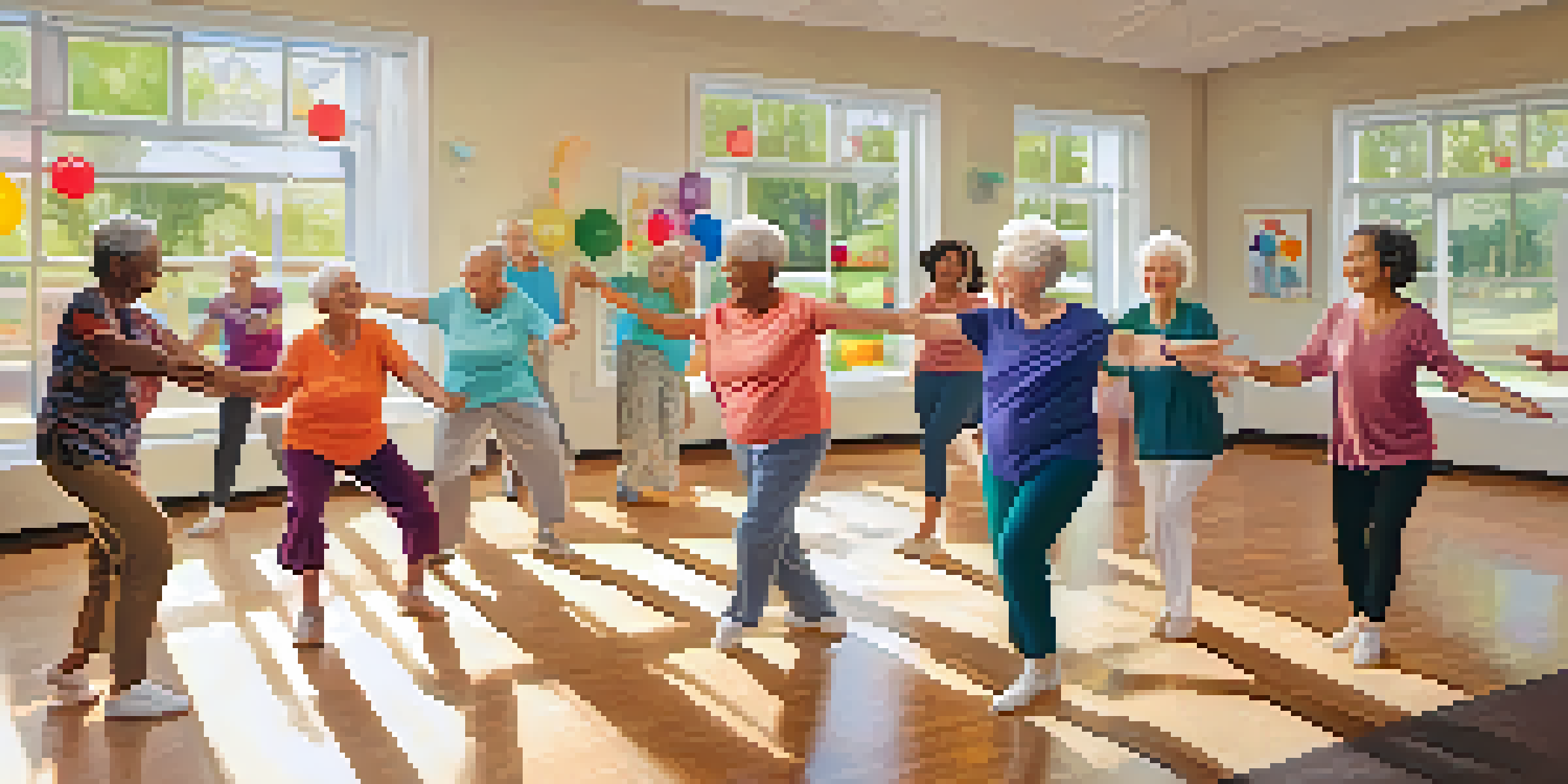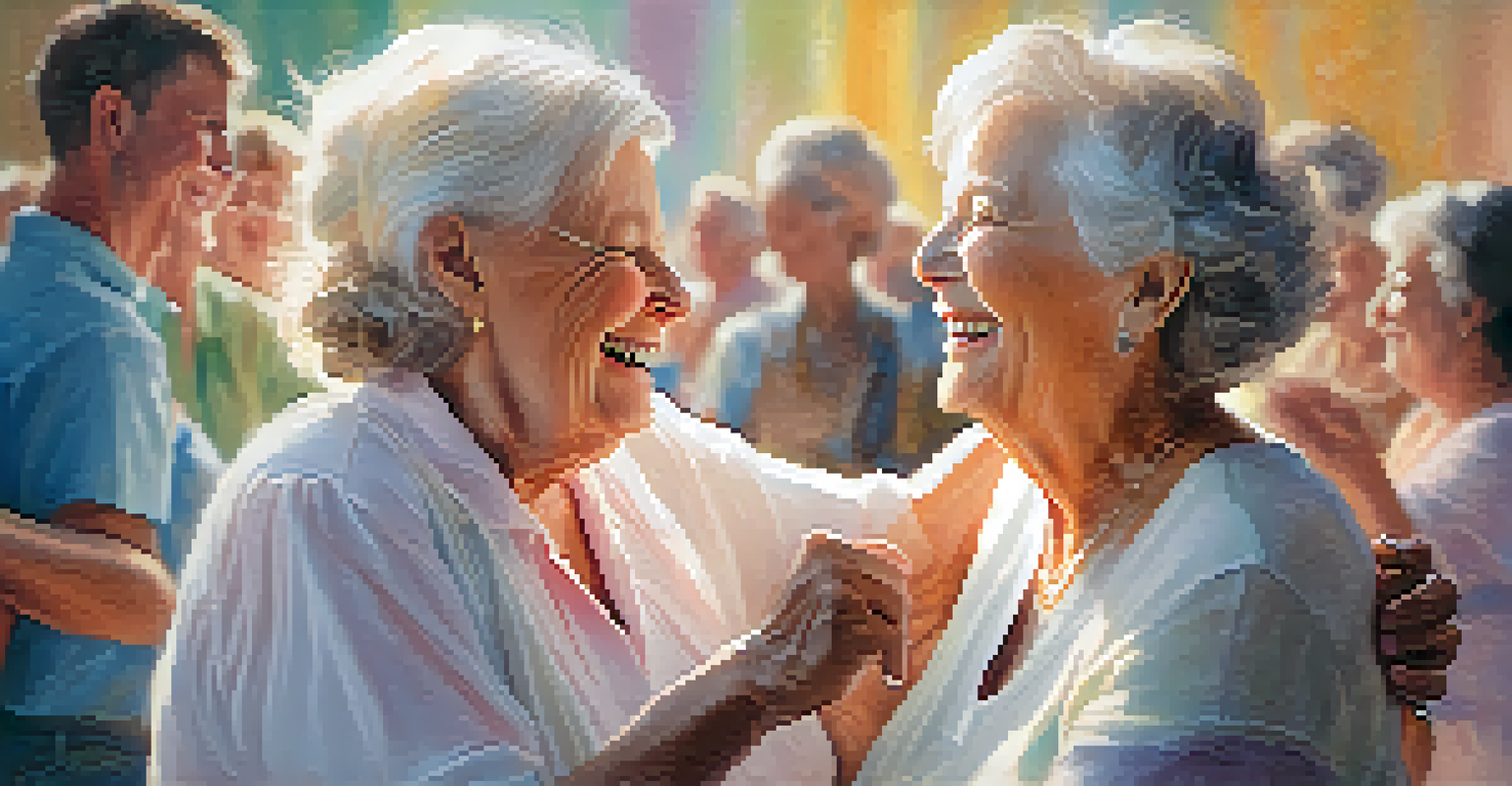Dance Therapy: Enhancing Memory in Aging Populations

Understanding Dance Therapy and Its Benefits
Dance therapy combines movement and creative expression to promote emotional, cognitive, and physical well-being. This therapeutic approach allows individuals to explore their feelings through dance, making it a unique form of therapy. For seniors, engaging in dance can stimulate both the body and mind, providing a joyful way to enhance overall health.
Dance is the hidden language of the soul.
One key benefit of dance therapy is its ability to foster social connections. Many seniors may experience feelings of isolation, but group dance sessions create a sense of community that can combat loneliness. By moving together, participants often form bonds that enhance their emotional well-being.
Additionally, dance therapy can improve physical health by promoting movement and flexibility. Regular participation helps seniors maintain their mobility, which is crucial for independence. With improved physical health, individuals often experience a positive ripple effect on their cognitive function, including memory.
The Connection Between Dance and Memory
Dance therapy can significantly improve memory in aging populations by engaging multiple areas of the brain. When dancing, individuals utilize rhythm, coordination, and memory recall—all of which help keep the brain active. This multi-faceted engagement makes dance an excellent tool for cognitive enhancement.

Research indicates that physical activity, including dance, encourages the growth of new neurons, a process known as neurogenesis. This is particularly important for memory function, as it helps counteract age-related decline. Dancing not only stimulates existing neural pathways but also creates new ones, encouraging better memory retention.
Dance Therapy Boosts Well-Being
Engaging in dance therapy promotes emotional, cognitive, and physical health, especially for seniors.
Moreover, the rhythmic patterns in dance can improve auditory processing and memory recall. Just as a catchy song can stick in your mind, the rhythms in dance reinforce memory through repetition and engagement. This can be especially beneficial for seniors dealing with memory challenges.
How Dance Therapy Is Implemented for Seniors
Dance therapy sessions for seniors are tailored to meet individuals at their unique abilities and interests. This personalization ensures that everyone can participate, regardless of their physical limitations. Activities may include simple movements, group dances, or even improvisational styles that allow for individual expression.
Movement is a medicine for creating change in a person's physical, emotional, and mental states.
In many cases, trained therapists lead these sessions, using their expertise to create a safe and encouraging environment. They often incorporate various styles of dance, such as ballroom, folk, or even chair dancing, to engage participants. This variety keeps things exciting and relevant, promoting consistent attendance and participation.
The sessions not only focus on dance but also integrate discussion and reflection. This dual approach encourages participants to express their thoughts and feelings, providing a holistic therapeutic experience. By blending movement with conversation, dance therapy fosters both cognitive and emotional growth.
Real-Life Examples of Dance Therapy Success
Many communities have seen remarkable outcomes from implementing dance therapy programs for seniors. For instance, a local senior center introduced weekly dance classes that resulted in improved social interactions and higher levels of happiness among participants. Seniors reported feeling more connected and engaged, helping to reduce feelings of isolation.
In another case, a study showcased a group of older adults who participated in dance therapy over several months. Participants demonstrated notable improvements in memory tests and cognitive function, highlighting the effectiveness of dance as a therapeutic tool. This real-world evidence reinforces the idea that dance can be a valuable ally in enhancing memory.
Dance Enhances Memory Function
Dance therapy activates multiple brain areas, significantly improving memory and cognitive function in aging populations.
Moreover, testimonials from participants often reveal personal transformations. Many describe not only improved memory but also increased confidence and joy in their lives. The positive changes experienced through dance therapy extend beyond the dance floor, enriching their overall quality of life.
The Role of Music in Dance Therapy
Music plays an essential role in dance therapy, acting as a catalyst for movement and memory recall. The right music can evoke emotions and memories, making it easier for seniors to connect with their past experiences. This connection can spark joy and promote engagement during therapy sessions.
Moreover, music can help enhance cognitive function by creating a familiar rhythm that participants can follow. This predictability can be comforting, especially for individuals with memory impairments, as it provides a structure to the dance experience. The repetitive nature of music reinforces memory retention and recall.
As participants dance to music, they often engage in storytelling through movement, which further stimulates the brain. This creative expression encourages the sharing of memories and experiences, creating a rich tapestry of connection and understanding among participants. Music, therefore, serves as both a backdrop and a powerful tool in dance therapy.
Potential Challenges and Considerations
While dance therapy offers numerous benefits, there are challenges to consider when implementing such programs for seniors. Physical limitations, mobility issues, or cognitive impairments can affect participants' ability to fully engage. It's essential for therapists to adapt sessions accordingly to ensure everyone can participate comfortably.
Additionally, some seniors may initially feel hesitant to join a dance class due to self-consciousness or fear of injury. Building trust and confidence within the group is crucial to overcoming these barriers. Therapists often use warm-up exercises and gentle encouragement to help participants feel more at ease.
Music Enriches Dance Therapy
Music serves as a powerful tool in dance therapy, evoking emotions and memories that enhance engagement and connection.
Finally, it's important to recognize that not every style of dance will resonate with every individual. Offering a variety of dance forms and encouraging personal expression allows seniors to find a style that suits them best. Tailoring the experience fosters a sense of ownership and enjoyment, leading to better outcomes.
Future Directions for Dance Therapy Research
As the popularity of dance therapy grows, so does the opportunity for research in this field. Future studies could explore the long-term effects of dance therapy on memory retention and cognitive decline. Understanding these impacts will help refine and enhance therapy practices tailored for seniors.
Moreover, researchers may investigate the specific types of dance that yield the most benefits for memory and emotional health. Different dance styles may engage various aspects of cognitive function, and uncovering these nuances can lead to more effective therapy programs. This research will be valuable for therapists looking to optimize their approaches.

Additionally, exploring the integration of technology with dance therapy could open new avenues for engagement. Virtual reality dance experiences or online classes could make this therapeutic approach accessible to even more seniors. Embracing innovation will ensure that dance therapy continues to evolve and meet the needs of aging populations.